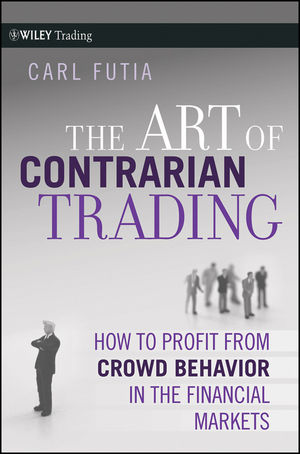The Art of Contrarian Trading: How to Profit from Crowd Behavior in the Financial MarketsISBN: 978-0-470-32507-0
Hardcover
240 pages
June 2009
 This is a Print-on-Demand title. It will be printed specifically to fill your order. Please allow an additional 10-15 days delivery time. The book is not returnable.
|
||||||
CHAPTER 1 Can You Beat the Market?
The Speculator's Edge.
Lending a Helping Hand to Investors.
Uncovering Market Mistakes.
Looking at the Evidence.
Market Timing.
Catch 22.
CHAPTER 2 Market Mistakes.
Efficient Markets.
Roller Coasters and Stock Markets.
Do Stock Prices Fluctuate Too Much?
A Look at Behavioral Finance.
Behavioral Finance and Exploitable Market Mistakes.
No Free Lunch Redux.
CHAPTER 3 The Edge.
A Theory of Market Mistakes.
To Get Along, Go Along.
Go Along and Create a Mistake.
The Social Calculus of Crowds.
The Vision of a Contrarian Trader.
CHAPTER 4 The Wisdom and Follies of Crowds.
Can a Crowd Be Wiser Than Its Members?
The Need for Collective Wisdom.
Independent Decisions in the Financial Markets.
Forecasting Market Psychology.
Information Cascades into the Whirlpool of Speculation.
CHAPTER 5 The Life Cycle and Psychology of an Investment Crowd.
Prologue.
The Cycle of Birth and Death.
The Stock Market Bubble of 1994-2000.
It's Different This Time: The New Information Economy.
Shattered Dreams: The Bear Crowd of 2001-2002.
Popular Instincts and the Search for Certainty.
The Pied Pipers of Investment Crowds.
The Mental Unity of Investment Crowds.
Suggestibility, Volatility, and Disintegration.
CHAPTER 6 The Historical Context for Market Mistakes.
Mature Investment Themes and Market Crowds.
Mistakes versus Fair Value.
Market Data Sources.
The Deadly Mistake.
When Is the Stock Market (Extremely) Overvalued?
When is the Stock Market Undervalued?
The Peak Oil Bubble.
CHAPTER 7 How Crowds Communicate.
What Do Information Cascades Tell Investors?
The Role of the Mass Media.
A Word about Personal Flexibility and the Future of Media.
Monitoring the Markets.
Studying the History of Bubbles and Crashes.
CHAPTER 8 Constructing Your Media Diary.
Gaining the Edge.
How My Diary Made a Difference in 2002.
Get Ready to Cut and Paste.
Excerpts from My Media Diary: November 2005.
Excerpts from My Media Diary: June 2006.
Interpreting Magazine Covers.
CHAPTER 9 Important Investment Themes.
Telling the Market's Story.
New Eras.
Effect of War and International Political Crises on the Stock Market.
Financial Crises Create Crowds.
New Industries and Companies.
Commodity Booms.
Interest Rate Movements and the Bond Market.
Using Your Media Diary to Track Investment Themes.
CHAPTER 10 Interpreting Your Diary: Market Semiotics.
Media and Information Cascades.
Your Media Diary: A Living History of Information Cascades.
Semiotics: The Study of Signs.
The Most Important Sign: The Price Chart.
Magazine Cover Stories.
Newspaper Headlines.
Front Page Stories and Editorials.
Crystallizing Events.
The Weight of the Evidence.
More on Market Semiotics.
CHAPTER 11 The Grand Strategy of Contrarian Trading.
Contrarian Investment Planning.
Contrarian Trader's Investment Portfolio.
The Investment Goal of the Contrarian Trader.
A Warning about Capital Gains Taxes.
Contrarian Trading Strategy #1: Don't Speculate.
Contrarian Trading Strategy #2: Don't Invest with the Crowd.
Contrarian Trading Strategy #3: Contrarian Rebalancing.
The Aggressive Contrarian.
A Long-Only Strategy for the Aggressive Contrarian Trader.
More Aggressive Contrarian Trading Strategies.
CHAPTER 12 The Great Bull Market of 1982-2000.
Prologue.
The 1987 Crash.
Interlude: The 1929-1932 Crash and Bear Market.
The S&L Crisis, the 1987-1990 Bull Market, and the 1990 Bear Market Crowd.
Rally without Joy, 1991-1994.
The Stock Market Bubble Inflates, 1995-2000.
The Aggressive Contrarian Faces the 1987 Crash.
The 1990 Low.
Long Term Capital Management Goes Bust.
Chapter 13 Collapse of the Bubble: The 2000-2002 Bear Market.
The End of the Great Bull Market.
Contrarian Rebalancing during the 2000-2002 Bear Market.
The Long Way Down Again.
Contrarian Rebalancing during the Crash.
The Aggressive Contrarian During the 2000-2002 Bear Market.
A Wall Street Wreck.
The Summer Rally.
The March 2001 Plunge.
Terrorists Attack on 9/11.
End of a Bear Market.
Transition to a New Bull Market.
CHAPTER 14 The Postbubble Bull Market of 2002-2007.
Escaping the Bear's Claw
What Bull? Looking for Signs of a Bullish Information Cascade.
The Story of Google's IPO.
The Housing Bubble.
Aggressive Contrarian Trading during the 2002-2007 Bull Market.
April 2005—A Buying Opportunity.
June 2006—Another Buying Opportunity.
Aggressive Contrarian Trading in Early 2007.
July-October 2007.
CHAPTER 15 The Panic of 2008.
The Conservative Contrarian during the Panic.
The Mortgage Mess.
The Debt-Deflation Spiral Takes Hold.
Lenders of Last Resort.
The Credit Crisis and the Contrarian Trader.
Bull Market Top and the First Step Down.
The Bear Stearns Failure.
Fannie and Freddie.
The Crash: Bankruptcy of Lehman Brothers.
CHAPTER 16 Vignettes on Contrarian Thought and Practice.
The Psychology of the Stock Market.
The Godfather of Contrary Opinion.
Opinion Polls: What Do You Think?
Is The Odd Lotter Always Wrong?
A Forecasting Giant of the Past.
Paul Montgomery, The Magazine Cover Contrarian.
Irrational Exuberance and Other Bubbles.
Value Investing—A Back of the Envelope Approach.
About the Author.
Index.



